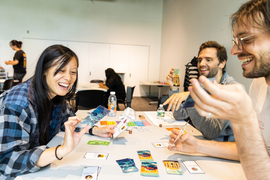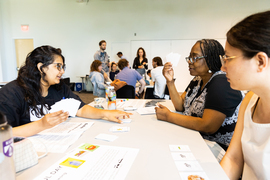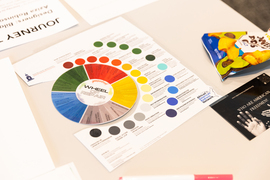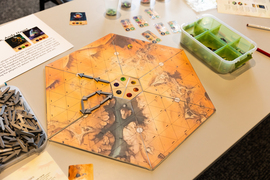On an otherwise sleepy Friday in late June, one corner of MIT’s Hayden Library was abuzz with the sounds of board gamers at play. Most of the gamers also happened to be first-time designers, and they had gathered to test out their maiden boards, some with the ink still drying.
“I printed my game this morning!” exclaimed Amruta Borwankar MBA ’23, who was fresh from completing her degree and had put off her return to India for the chance to design her own game. “I didn’t want to miss it because this is the only place that offers this kind of opportunity.”
That opportunity was a summer workshop in board game design, sponsored by the Council for the Arts at MIT and the MIT MindHandHeart Innovation Fund, and open to family, friends, and members of the MIT community. The workshop was led by Doris Qingyi Duanmu SM ’23, an MIT graduate student in urban studies, and Ziye Zhang, a game designer from New York University.
Over two weeks, the instructors ran participants through a crash course in the history and mechanics of board game design, and then set them up with materials, fabrication tools, online resources, and the goal of delivering a playable game at the workshop’s final Friday showcase. Their message to the fledgling designers: Any idea has gameplay potential.
In particular, the workshop emphasizes the idea that games can be a gateway into social and cultural topics that otherwise may be challenging to engage with in daily life.
“Board games can bring people together around the table and open up a topic, even an uncomfortable one, through their playfulness,” Duanmu notes. “It doesn’t mean that board games can solve a social problem, but they can help facilitate a conversation that could lead to decisions and solutions.”
Game history
Designing games as tools for progress is not a new idea. As Duanmu and Zhang reference in the workshop, the classic, cut-throat, capitalist game of “Monopoly” originally had more progressive intentions.
The game’s roots are meandering and surprisingly contentious, and can ultimately be traced back to Elizabeth “Lizzy” Magie. At the turn of the 20th century, Magie invented the “Landlord’s Game” — a setup that clearly resembles the modern “Monopoly,” with a board printed with various real estate properties, along with game pieces, play money, cards of chance, and the infamous command to “Go to Jail.”
Interestingly, Magie’s version could be played in one of two ways: either as competitive monopolists, in which players try to ruthlessly buy up more properties and accumulate more wealth than their opponents; or as more cooperative “anti-monopolists,” where everyone receives some benefit each time a player acquires some wealth. In Magie’s view, the game was meant to educate players on the tensions between capitalism and communalism. As it happened, capitalism won out, at least in terms of the game’s ultimate, commercial form.
And indeed, many board games developed through the 20th century were designed with similar competitive, land-grabbing, and even colonialist themes. Only recently have commercial-scale board games begun to feature more socially and culturally diverse themes.
In their workshop, Duanmu and Zhang cite Wingspan, a beautifully illustrated, card-driven board game that hit shelves in 2019, as one example of an enormously successful game with a seemingly niche theme (the habits and habitats of wild birds). They anticipate that Votes for Women, another tabletop game developed in 2022, could have a similar unconventional appeal. That game centers on the women’s suffrage movement, and to win the game, players must play cards that encourage the passage of the 19th amendment and states’ ratification of women’s right to vote.
“There’s a trend in the game production field now where designers are starting to focus on ways to showcase a particular idea,” Zhang says. “A lot of commercial games are mechanically heavy but are borrowing a theme, usually overlooking the social, educational, and intellectual aspects of board games. But if you have an irreplaceable idea that you’re designing as a game, that could change the market.”
Story and rhythm
Last spring, Duanmu fell upon a game idea of her own. As part of her studies in personal narratives and urban design, she had been researching the stories of Afghan refugees and the harrowing paths they’ve been forced to take to flee their country.
“I drew up a map showing all the routes they could choose, and I thought, this could be a perfect game board, and a way to tell their story,” says Duanmu, who is working with Zhang to refine the design. She is quick to emphasize that the game’s intent is not to romanticize or downplay the refugees’ plight, but rather to raise awareness and open dialogue on the issue.
“For those of us who are privileged enough to play, this kind of game could create a collective discomfort that we share within a game space,” she says. “That could make you want to know more about their background story and perhaps do something about it after the game is over.”
As they worked through the game’s mechanics and plot, the team had a thought: Perhaps they could teach others how to design board games with social and cultural stories at their core.
In January 2023, they offered the first board game design workshop during MIT’s Independent Activities Period. In that session, participants came up with preliminary designs for game ideas, ranging from maintaining environmentally sustainable industries in the Philippines, to managing the balance and flow of stories in a daily newsroom. The overwhelmingly positive response spurred Duanmu and Zhang to do it again. The most recent workshop, over two weeks this past June, drew participants with similarly diverse ideas that the duo helped guide into game form.
“Many of our participants are first-time designers, and we feel that starting with stories is an easier and more powerful way to get them started,” Zhang says. “A story needs a plot, a rhythm to the story, ups and downs, and those things can be turned into game mechanics that can tell and advance the story.”
Unlikely play
In the workshop’s final Friday showcase, about a dozen participants — a mix of students, postdocs, staff members, and MIT affiliates — set up their finished games and took turns play-testing and giving feedback on their classmates’ designs, which ranged from simple card games to more elaborate, 3D-printed constructions. Game themes ran an even wider gamut, exploring everything from human psychology and social relationships to library science, modern piracy, work/life balance, and supply chains in a depleted world.
Borwankar, the recent MBA graduate, managed to display two games: an array of tiles, each challenging a player to perform a silly exercise, or an act of kindness (compliment your neighbor — earn 7 points); and a game of government, where a player, acting as a head of state, must learn to balance various political actions with fiscal budgets and party votes.
“I think it’s important for kids to be aware of these tradeoffs,” says Borwankar, who brought her two young sons to join in the fun. “By playing the game, it could help them realize, next time they listen to a politician’s populist speech, that it’s not necessarily going to improve GDP — it’s just for votes.”
Across the room, Aziza Robinson-Goodnight displayed hexagonal tiles and a spinning wheel as part of her design, inspired by an unlikely game topic: reparations and the movement to collectively heal the Black community.
“Communities are so bogged down with the day-to-day that they can’t think about the [historical] harm that’s inflicted on them, and the repair,” says Robinson-Goodnight, a Boston-based artist and activist who works with MIT’s Community Innovators Lab (CoLab). “I wanted to create a game where folks can take a journey through repair, and spark collective thinking around the repair of the harm.”
She plans to pitch the game to schools and community centers as a playful way into a hard though necessary conversation.
“Seeing the game, finished, is the most rewarding thing,” she says of her workshop experience. “I studied and taught art for 15 years, and it’s like, give me the tools, I can do the thing! I loved it.”
Duanmu and Zhang plan to offer the workshop next year during IAP 2024.
“We want to give everyone an introductory and hands-on experience to design a game that tells the stories they want,” Duanmu says. “We want to show them it’s all possible.”



















